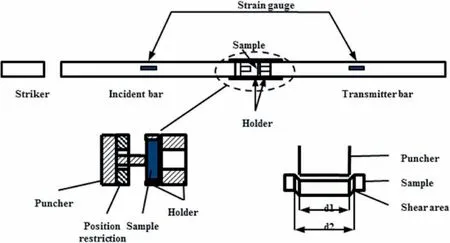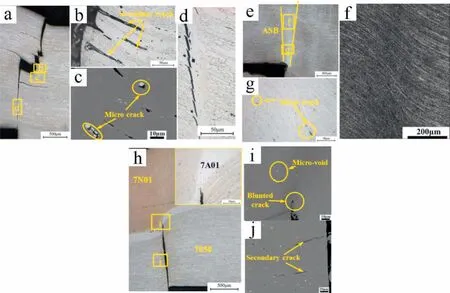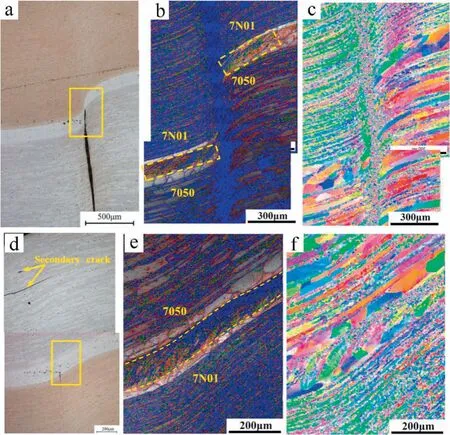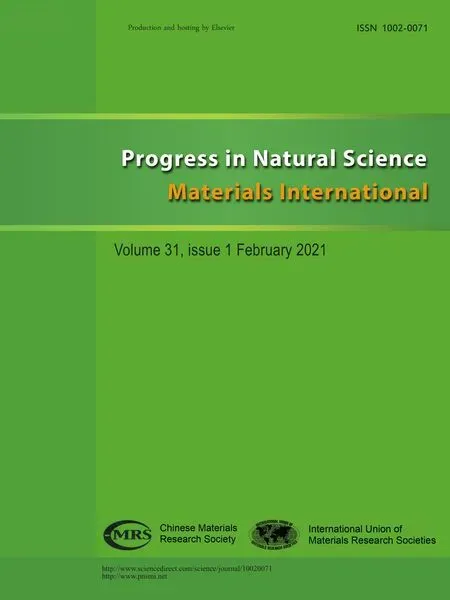Dynamic response characteristic of 7N01/7A01/7050 aluminium multilayer plate at high strain rate
Guochuan Zhu ,Xiwu Li ,Baiqing Xiong ,Zhihui Li ,Yongan Zhang ,Lizhen Yan ,Kai Wen,Hongwei Yan
a State Key Laboratory of Nonferrous Metals and Processes,GRINM Group Co.,LTD.,Beijing,100088,China
b GRIMAT Engineering Institute Co.,LTD.,Beijing,101407,China
cGeneral Research Institute for Nonferrous Metals,Beijing,100088,China
d State Key Laboratory for Performance and Structural Safety of Petroleum Tubular Goods and Equipment Materials,CNPC Tubular Goods Research Institute,Xi’an,710077,China
Keywords:Multilayer structure Structural Adiabatic shear band Fracture
ABSTRACT The correlations between the structures,fracture behavior and dynamic shear property were investigated for 7050 to 7N01 layer of 7N01/7A01/7050 multilayer plate with different thickness ratio fabricated by hot rolling bonding.is The results showed that when thickness ratio of 7050 to 7N01 layer was 1 and 7050 layer was backplane,the absorbed energy of the multilayer plate was 39% higher than that of 7050 alloy.The excellent energy absorbing ability of 7N01/7A01/7050 multilayer plate is attributed to the blunted cracks in 7A01 interlayer,the enhanced 7050 layer by decreasing of secondary cracks and the delaying dynamic failure of 7050 layer.
1.Introduction
The Al-Zn-Mg-Cu alloy system in T6 heat treatment possesses the highest strength among the heat-treatable aluminium alloys [1].However,these high alloying aluminium alloys exhibit low fracture toughness,which limits their extensive application [2,3].Recently,the metallic multilayer composites have received attention due to their striking characteristics.Laminated metal composites are a unique form of composite material in which alternating metal or metal containing layers are bonded together with discrete interfaces[4].These kind of laminated structures are promising as an important class of materials for improved fracture toughness [5,6],damage tolerance [7],impact behavior [8],damping [9],and fatigue resistance [8],and enhanced formability and ductility for otherwise brittle materials.The studies show that aluminum laminates are capable to enhance mechanical behavior of their constituent materials [5,10-12].According to their hypothesis [11],the delamination at the interface can improve toughness by reducing crack tip triaxiality and redistribution of the local stresses.The crack renucleation also contributes to toughening by energy consumption for initiation of the new crack.Therefore,many studies have been carried out in Al/Al laminated metal composites effectively combined high strength with good ductility.The aim of this work is to provide fundamental insights into the interrelationships between the thickness ratio,structure and dynamic response,fracture behavior of Al/Al laminated metal composites.
2.Experimental
The 7N01/7A01/7050 multilayer plate was manufactured by 7050 plate(105 mm),7N01plate(40 mm)and 7A01 plate(1 mm),then 7050/7A01/7N01 layers hot rolled at 370°C by 20 passes of a total reduction of 90%(146:15).Then,the plate was solution treated at 475°C for 2 h and aged at 120°C for 24 h.The dimension of shear samples in dynamic shear experiment was Φ11×3 mm,and the thickness of 7N01 layer in multilayer samples were processed to 0.5 mm,1.5 mm and 2.5 mm,while the thickness of 7050 and 7N01 monolayer was 3 mm.
A schematic of the SHPB test configuration is shown in Fig.1.The designed shear specimen was sandwiched between the incident and transmission bars.The impact bar was launched from a gas gun at a predetermined velocity towards the incident bar.Based on the onedimensional elastic stress wave theory and considering the design form of flat hat-shaped sample,the shear stress,the shear displacement,the nominal shear strain and the nominal shear strain rate can be calculated by following formulas:

Fig.1.Schematic of the SHPB test configuration.

where εiand εtare the incident and transmitted strain pulses,which can be obtained by the strain gages bonded on the bars,respectively.w is the width of shear area,w0.5(d2-d1),d1and d2are 5 and 6 mm,respectively.c0,E and Abare the stress wave velocity,elastic modulus,crosssectional area of incident and transport bar,respectively.

Where Dbis the diameter of loading bars,which is 14.5 mm,H is the thickness of shear sample,which is 3 mm.
The per unit volume shear energy of the shear deformation area can be calculated as follows:

The shear energy consumption in the whole process is:

All the shear samples were tested at room temperature,and then cut in half along the longitudinal direction after the tests.The surface morphologies,especially the concentrated shear zone of the impacted specimens were then examined by optical microscope (OM) and SEM.The mechanical polished half section of the specimens were then electropolished to remove the surface residual stress to reveal the image quality(IQ)and inverse pole figure(IPF)for EBSD.
3.Results and discussion
Fig.1 shows the dynamic shear stress-strain curves and energy absorption per unit volume of the monolayer and multilayer samples.The shear stress of 7050 alloy was much higher than that of 7N01 alloy,but the failure strain of 7N01 alloy was approximately two times of 7050 alloy.The shear stress of multilayer samples is lower than 7050 alloy and higher than 7N01 alloy,and the shear stress decreased as the increase of 7N01 layer thickness in multilayer sample.Meanwhile,when 7050 layer was face plate during loading the shear stress-strain curves of multilayer samples had two stress plateaus.When the strain was larger than 1,the shear stress decreased deeply to the second plateau.Fig.1b shows the stress-strain of multilayer samples when 7050 layer was backplane.The stress-strain curve of the multilayer samples only had one plateau compared with the samples that 7050 layer was faceplate during loading.It can be seen from Fig.1c that the energy absorption of multilayer samples increased firstly then decreased as the increase of 7N01 layer thickness in the multilayer samples.When 7050 layer was backplane,the energy absorption of multilayer samples were higher than that when 7050 layer was faceplate.The absorbed energy per unit volume of multilayer sample reached to the peak value when the thickness 7N01 and 7050 layer were both 1.5 mm,and the energy absorption per unit volume of the multilayer sample when 7050 layer as faceplate was 345.17 J/cm3which is 21% higher than that of 7050 alloy.However,when 7050 was backplane the energy absorption of the multilayer sample was 37%than that of 7050 alloy.The lower ability of absorbing energy of the multilayer samples when 7050 layer was faceplate may cause by the second stress plateau in stress-strain curve.
The microstructures in the shear zone of the monolayer sample and multilayer sample in the case of 7050 layer as faceplate at the strain 1 are shown in Fig.2.The OM microstructure of 7050 alloy showed that the crack propagated though the whole 7050 momolayer sample along the thickness direction when the strain was 1,and higher magnification SEM image showed that the crack propagated along the adiabatic shear band.Also,the secondary cracks nucleated and propagated along grain boundaries.Under dynamic loading,the failure mechanism of 7050 momolayer was dominated by the adiabatic shear band,and the crack initiation and propagation[15].While no obvious cracks were found in 7N01 momolayer sample at the same strain,and the formation the adiabatic shear band was found along thickness direction(Fig.2e).The EBSD image of ASB shows that the bend degree of grains decreases along the loading direction,indicating that the inhomogeneous plastic deformation occurred in 7N01 sample.Higher magnification of the adiabatic shear band reveals that the micro-cracks nucleated at the cracked second phase particles.It can be seen in Fig.2h that the crack propagated though the whole 7050 layer in multilayer,then the crack was blunted at 7A01 interlayer,and no obvious cracks formed in 7N01 layer.Higher magnification of the crack tip indicates that the crack blunting at 7A01 interlayer caused by severe plastic deformation of 7A01 layer(Fig.2i).And no obvious ASB was found in 7N01 layer.Also,some secondary cracks were observed in the crack path with higher magnification in 7050 layer.The length of the secondary crack (100 μm) was much lower than that in 7050 monolayer sample (>200 μm).With the addition of 7N01 layer,pronounced effect on fracture behavior of 7050 layer could be observed in multilayer sample.The fracture behavior of the multilayer composite indicates that the second stress plateau in multilayer sample was caused by the fracture sequence of 7050 and 7N01 layer in the multilayer samples when 7050 layer was faceplate during loading.It is believed that the ability of the energy absorbing of the multilayer sample was enhanced by blunted crack at 7A01 layer combined with the change in fracture behavior of 7050 layer.
The OM and EBSD micrographs of the multilayer sample at strain 1 when 7050 layer was faceplate and backplane are shown in Fig.3.Fig.3a illustrates the microstructure of the deformed area in 7A01 interlayer of the multilayer sample when 7050 layer was faceplate.The crack propagated through 7A01 layer,and the IQ map of 7A01 layer indicates that 7A01 layer had experienced severe plastic deformation before fracture.The total length of the deformed area is less than 300um,and the deformed degree of 7A01 layer is inhomogeneous,much higher at the area adjacent to crack tip.The fracture of 7050 layer indicates that 7050 layer was no longer able to absorb energy when strain over 1.The microstructure of the deformed area in 7A01 interlayer of multilayer sample when 7050 layer was backplane is shown in Fig.3d-e.When 7050 layer was backplane,no obvious cracks were found in the deformed area in both 7050 and 7N01 layer.The IQ image indicates that homogeneous deformation occurred in both 7050 and 7N01 layer during loading,but the morphology of the grains in 7A01 layer show homogeneous deformation.The deformed microstructure in 7A01 layer was different with 7050 and 7N01 layer,and the grains adjacent to 7050 and 7N01 layer were elongated and bended,while fine sub-structures with low-angle grain boundaries formed inside 7A01 layer.And the length of deformation area was longer than 600 μm.IPF image of 7N01 layer indicates that the sub-structures inside 7A01 layer when 7050 layer was faceplate was finer than that when 7050 layer was backplane.

Fig.2.Microstructure of the shear area in the monolayer and multilayer samples at the strain of 1:(a)-(d) for 7050 monolayer sample:(a) panorama,(b) amplification of area b,(c) amplification of area c,(d) amplification of area d;(e)-(g) for 7N01 monolayer sample:(e) panorama,(f)pattern quality map of area f,(g)amplification of area g;(h)-(j) for multilayer sample with the thickness 1.5 mm of 7050 as faceplane:(h) panorama,(i) amplification of area i,(j) amplification of area j.

Fig.3.Microstructure of shear area in multilayer structure with the thickness of 1.5 mm of 7050 at the strain of 1:(a)-(c):with 7050 layer as faceplane:(a)Panorama,(b)IQ image of local amplification,(c)IPF image of local amplification;(d)-(f):with 7050 layer as backplane:(d)Panorama,(e)IQ image of local amplification,(f)IPF image of local amplification.
During dynamic loading,7050 alloy showed high strength and low plasticity,while 7N01 alloy showed low strength and high plasticity,which resulted in less difference in per unit volume absorbed energy between 7N01 alloy and 7050 alloy.In the multilayer samples,the severe 7A01 interlayer plastic deformation induced crack blunted and the decrease of the secondary cracks in 7050 layer to enhance the ability of energy absorbing by increasing the crack nucleation and propagation energy.However,when 7050 layer was backplane,the homogeneous deformation was foundin multilayer sample,and only secondary cracks propagated along grain boundary perpendicular to loading direction with no adiabatic shear band formation along loading direction,which means the delaying dynamic failure of 7050 layer.The delaying dynamic failure of 7050 layer enhanced the nucleation energy of the adiabatic shear bands and the cracks in 7050 layer,resulting in higher absorbed energy than that when 7050 layer was faceplate.Also,it explain only one stress plateau to appear in stress-strain curve in multilayer sample when 7050 layer was faceplate.
4.Conclusions
The fracture behavior and mechanical properties of 7N01/7A01/7050 multilayer plate under dynamic impact loading have been investigated.The experimental results reveal that the multilayer plate shows much higher absorbed energy when the thickness ratio of 7050 to 7N01 is 1.The strengthening mechanism of multilayer structure is attributed to the severe 7A01 interlayer plastic deformation,which induces the crack blunted and the decrease of the secondary cracks in 7050 layer.Also,when 7050 layer is backplane,the multilayer samples show a much high absorbed energy compared with the multilayer plate with 7050 layer as the faceplate,which is induced by the delaying dynamic failure of 7050 layer,and resulting in higher nucleation energy of the adiabatic shear bands and the failure of 7050 layer.
Acknowledgments
The authors are very grateful for the support received from the National Program on Key Basic Research Project (973 Program) of China(No.2012CB619504) the National Key Research and Development Program of China(No.2016YFB0300903).
 Progress in Natural Science:Materials International2021年1期
Progress in Natural Science:Materials International2021年1期
- Progress in Natural Science:Materials International的其它文章
- Synergetic effect of multiple phases on hydrogen desorption kinetics and cycle durability in ball milled MgH2-PrF3-Al-Ni composite
- Growth mechanisms of Ag and Cu nanodendrites via Galvanic replacement reactions
- Highly mechanical and high-temperature properties of Cu-Cu joints using citrate-coated nanosized Ag paste in air
- Ab-initio investigation for the microscopic thermodynamics and kinetics of martensitic transformation
- Rapid directionally solidified microstructure characteristic and fracture behaviour of laser melting deposited Nb-Si-Ti alloy
- Microstructure evolution and mechanical properties of a hot-rolled Ti alloy
